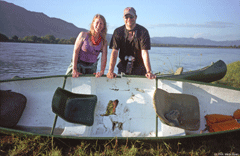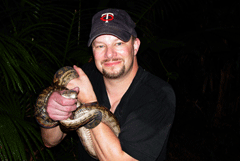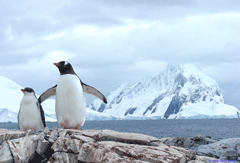Intrepid Travelers
Air Date: Week of June 22, 2007

Marty and Deb after they survive a hippo overturning their canoe. Credit: Photo: Brian Worsely
Just before he turned forty, author and photographer Marty Essen decided he hadn’t seen enough of the world. So he and his wife set out on a voyage to explore the seven continents and document the creatures they encountered. Essen talks with Bruce Gellerman about his book, “Cool Creatures, Hot Planet; Exploring the Seven Continents.”
Transcript
GELLERMAN: The other day I took out a map of the world and thought if I could go anywhere, anywhere in the world where would I go? Well, unfortunately, I only got as far as the internet but when Marty Essen got the urge to get up and go for an adventure he got up and went and didn’t come back for the next three and a half years, during which time he hit all seven continents.
After years in a mild-mannered job Essen got bit hard by the travel bug and took off with his wife Deb. Their adventures took them off the beaten path. Along the way they had many close encounters with some of the worlds most unusual and deadliest plants and animals from poisonous stinging trees to pythons, piranhas, hippos and penguin poo.
Marty Essen chronicled his adventures in the travel award winning book “Cool Creatures, Hot Planet.” Marty Essen joins us from Missoula, Montana where he hangs his hat when he’s home. Marty, welcome.
ESSEN: Well, thank you for having me on.
GELLERMAN: You’re closing in on the big 4-0 and boy you go around the world looking for dangerous animals.
ESSEN: Well, I love dangerous animals. When I reached 39 years old and realized I hadn’t been seeing many of these animals I decided it was time to get out and have some fun.
GELLERMAN: Your book is called “Cool Creatures, Hot Planet.” What’s the coolest creature?

Marty with a seven-and-a-half foot Amethystine Python (Photo: Chris Leach)
GELLERMAN: You have a very close encounter with what I was told is the most dangerous animal actually in the world and that’s the hippo. And I was surprised by that.
ESSEN: Well, you know what we did for Zimbabwe, is the first part of our trip, we hiked 53 miles across Mana Pools National Park. And saw great wildlife as we went across. And then what we did is we got into canoes and headed down the Zambezi River. My wife and I are canoeing along shore, and we feel this little bump. And next thing you know my wife, and I are six feet up in the air. The hippo had come underneath us. Its lower tusks went right through the bottom of the canoe and its top jaw came over the gunwale. And then if you can imagine a front end loader lifting gravel and dumping it into a truck, that’s what the hippo did with us. It lifted us up six feet in the air and then dumped us on shore. I can still see it in slow motion as my wife hits the ground in this crumpled heap and I’m thinking, “Oh my God my wife is dead.” And I run up to her, “Deborah are you ok? Are you ok?” And we looked at each other and realized we were ok and broke into hysterical laughter. How may people get a chance to live through a hippo attack?

Marty and Deb after they survive a hippo overturning their canoe. (Photo: Brian Worsely)
ESSEN: Well, we weren’t necessarily, no we’re not looking for trouble. But sometimes it happens.
GELLERMAN: You know there’s Steve Irwin, the Crocodile Hunter, who died so terribly not too long ago. And you take many of the risks I think that he takes actually, and I’m wondering what’s the place for a person like you in this world. Is that really responsible? I guess that’s my question.
ESSEN: With Steve Irwin the Crocodile Hunter, after he died there was so much controversy with people saying well he got too close to animals. And the answer to that is yes he did get too close to animals. But you’ve got to look at the good that does. For instance, when I go to schools and I talk to students and I bring out my snakes. If I had done that anytime before the Crocodile Hunter existed I would have had people cowering in corners trying to get away because they wouldn’t want to be anywhere in a room with a snake. Yet, now these kids get all excited about the fact that they can see a snake and they want to hold the snake. The more people understand animals that aren’t necessarily warm and cuddly the more they’re going to want to protect them.

Author Marty Essen (Courtesy of Encante Press)
ESSEN: Well, yeah we had a 25 pound weight limit. When you’re a photographer like I am, that takes up half your weight. If I have to leave my underwear home I’m going to leave it. Yeah I ended up doing that whole trip without underwear because I was not leaving my camera gear at home.
GELLERMAN: Well, you came back with some great pictures.
ESSEN: Well, one of the photos that I have which is from the Amazon chapter, is a white orchid mimic spider, that I believe I’m the first person in the world to ever photograph. It’s just a bizarre looking spider.
GELLERMAN: Oh, I see him. It looks like an orchid.
ESSEN: It looks like an orchid.
GELLERMAN: On the cover of your book is a picture of you and there’s an animal over your left eye. What is that?

Gentoo Penguins in Antarctica (Courtesy of Marty Essen)
GELLERMAN: I hope you wore your underwear that day.
ESSEN: (laughing) Yeah, I wore my underwear that day.
GELLERMAN: Marty, thank you very much. I had a great time talking with you.
ESSEN: Well, I had a great time talking with you, Bruce.
GELLERMAN: Marty Essen’s new book is called, “Cool Creatures, Hot Planet: Exploring the Seven Continents.” You can see more of his pictures and a link to his Web page at our Web page loe dot org.
[MUSIC: Ry Cooder "Cherry Ball Blues" from 'Boomer's Story' (Reprise Records -1972)]
Links
Living on Earth wants to hear from you!
Living on Earth
62 Calef Highway, Suite 212
Lee, NH 03861
Telephone: 617-287-4121
E-mail: comments@loe.org
Newsletter [Click here]
Donate to Living on Earth!
Living on Earth is an independent media program and relies entirely on contributions from listeners and institutions supporting public service. Please donate now to preserve an independent environmental voice.
NewsletterLiving on Earth offers a weekly delivery of the show's rundown to your mailbox. Sign up for our newsletter today!
 Sailors For The Sea: Be the change you want to sea.
Sailors For The Sea: Be the change you want to sea.
 The Grantham Foundation for the Protection of the Environment: Committed to protecting and improving the health of the global environment.
The Grantham Foundation for the Protection of the Environment: Committed to protecting and improving the health of the global environment.
 Contribute to Living on Earth and receive, as our gift to you, an archival print of one of Mark Seth Lender's extraordinary wildlife photographs. Follow the link to see Mark's current collection of photographs.
Contribute to Living on Earth and receive, as our gift to you, an archival print of one of Mark Seth Lender's extraordinary wildlife photographs. Follow the link to see Mark's current collection of photographs.
 Buy a signed copy of Mark Seth Lender's book Smeagull the Seagull & support Living on Earth
Buy a signed copy of Mark Seth Lender's book Smeagull the Seagull & support Living on Earth

